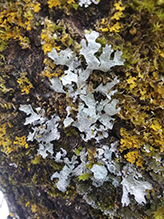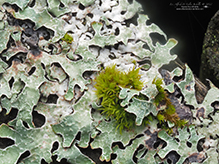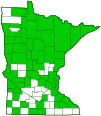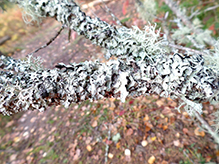Hammered Shield Lichen
(Parmelia sulcata)
Conservation • Description • Ecology • Distribution • Taxonomy
|
|
||||||||||||||
Description |
Hammered Shield Lichen is a widespread, abundant, weedy lichen. It is one of the most common lichens worldwide. It occurs across the northern hemisphere, in southern Africa, and in Australia. It is very common in Minnesota. It grows on the bark of deciduous and coniferous trees in relatively open habitats, disturbed sites, and agricultural lands. It also grows on mossy rock, but only rarely grows on soil. The vegetative body (thallus) is leaf-like (foliose), greenish-gray to whitish-gray, more or less circular in outline, and divided into branches (lobes). The lobes are flat, 1 ⁄16″ to 3 ⁄16″ (2 to 5 mm) wide, widely spreading, overlapping, and touching but separate, not fused together. The tips are abruptly squared, as if cut off (truncate). The upper surface is shiny but sometimes has a white, flour-like or frost-like covering (pruinose). It has abundant powdery granules (soredia). It does not have shiny granules (isidia). It may be smooth but usually has a network of sharp ridges and depressions giving it a “hammered” appearance. This is the feature that gives the lichen its common name. It has minute, elongated, rounded openings (pseudocyphellae), and sometimes develops cracks along prominent pseudocyphellae. The lower thallus surface is black and is moderately to densely covered with black, unbranched root-like structures (rhizines). When wet, the thallus can usually be removed intact with a knife. Hammered Shield Lichen rarely produces disk-like spore producing structures (apothecia). When present, they are 1 ⁄16″ to 5 ⁄16″ (2 to 8 mm) wide and have a dark brown disc. |
Similar Species |
Ecology |
Substrate |
Trees |
Growth Form |
Foliose |
Habitat |
Open habitats, disturbed sites, and agricultural lands. |
Hosts |
Trees and mossy rock. |
Use |
Crottles are various lichens that were used to make dyes. Parmelia sulcata, sometimes called “Powdered Crottle”, was used as the source for a reddish-brown dye. Unlike most lichens, Hammered Shield Lichen is tolerant of air pollution. It is often used as an indicator of air quality in natural areas. |
Distribution |
||
|
Sources |
|
| 4/29/2024 | ||
Occurrence |
||
Very widespread and abundant |
||
Taxonomy |
|
Kingdom |
Fungi (Fungi) |
Subkingdom |
Dikarya |
Phylum |
Ascomycota (Sac Fungi) |
Subphylum |
Pezizomycotina (Sac Fungi and Lichens) |
Class |
Lecanoromycetes (Common Lichens) |
Subclass |
Lecanoromycetidae (Shield Lichens, Sunburst Lichens, Rosette Lichens, and Allies) |
Order |
Lecanorales (Shield Lichens, Rim Lichens, and Allies) |
Family |
Parmeliaceae (Shield Lichens and Allies) |
Subfamily |
Parmelioideae (Typical Shield Lichens) |
Genus |
Parmelia (shield lichens) |
Mycobiont |
Parmelia sulcata |
Photobiont |
|
Subordinate Taxa |
|
|
|
Synonyms |
|
Parmotrema sulcata Parmotrema sulcatum |
|
Common Names |
|
Cracked-shield Lichen Furrowed Shield Lichen Hammered Shield Lichen Powdered Crottle Powdered Shield Shield Lichen Waxpaper Lichen |
|
Glossary
Apothecium
An open, disk-shaped or cup-shaped, reproductive structure, with spore sacs on the upper surface, that produces spores for the fungal partner of a lichen. Plural: apothecia.
Foliose
Adjective: Leaf-like growth form; referring to lichens with leaf-like growths divided into lobes.
Noun: The leaf-like, vegetative body of a lichen (thallus) that has thin, flat lobes which are free from the substrate.
Isidium
An asexual reproductive structure of a lichen in the form of a tiny outgrowth of the upper cortex. It consists of a cluster of algal cells (the photobiont) wrapped in fungal filaments (the mycobiont), and a shiny outer layer of protective tissue (cortex). Plural: isidia.
Rhizine
A root-like structure of a lichen that attaches the lower layer to the substrate.
Soredium
An asexual reproductive structure of a lichen in the form of a tiny dull granule on the thallus surface that can be easily brushed off. It consists of a cluster of algal cells (the photobiont) wrapped in fungal filaments (the mycobiont), but without an outer layer of protective tissue (cortex). Plural: soredia.
Thallus
The vegetative body of a lichen composed of both the alga and the fungus.
Visitor Photos |
||
Share your photo of this lichen. |
||
This button not working for you? |
||
Luciearl |
||
 |
 |
|
lichens on red oak |
||
 |
||
Alfredo Colon |
 |
MinnesotaSeasons.com Photos |
||
|
|
|
|
|
|

Slideshows |
|

Visitor Videos |
||
Share your video of this lichen. |
||
This button not working for you? |
||
|
Other Videos |
||
|

Visitor Sightings |
||
Report a sighting of this lichen. |
||
This button not working for you? |
||
| Luciearl 2/27/2025 |
Location: Cass County lichens on red oak |
| Luciearl 12/29/2024 |
Location: Fairview Twp. |
| Luciearl 2/20/2024 |
Location: Baxter, Crow Wing County |
 |
Alfredo Colon |
Location: Albany, NY |
 |
Luciearl |
Location: Superior Hiking Trail, Cook County |
 |
MinnesotaSeasons.com Sightings |
||
|

Created: 11/25/2019 Last Updated: © MinnesotaSeasons.com. All rights reserved. |



